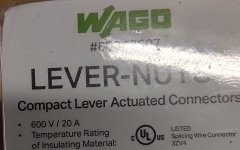Seems like excellent supplemental testing good for 15A continuous use at 480Vac.
With 2 test standards, 1 suitable for 600Vac @ 60min intervals, Lever-Nuts seem superior to most twist on's, inner tube, or tape.
WAGO's website shows all Lever-Nuts® with 2 listing standards:
IEC (EN 60xxx), Ambient, Series, UL (486C Non-Continuous)
450v, 32A, 105°c, 85°c, 221-41x, 600v, 20A, 75°C, 30°C, #24-12awg
450v, 41A, 105°c, 85°c, 221-61x, 600v, 30A, 75°C, 30°C, #20-10awg
450v, 32A, 85°c, +40°c, 222-41x, 600v, 20A, 75°C, 30°C, #28-12awg
Your 15A continuous 480v motor only pushes half ampacity of 221-61x series, or 75% of the others.
Pushing max ampacity continuously may be risky, but your test is within the limits.

